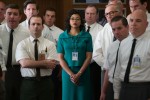“Hidden Figures” may lack CGI explosions and action-packed fight scenes, but make no mistake – it’s a superhero film.
The film relies on the conventional biopic formula – hardship and triumph, based on a true story – but manages to refresh the genre with its powerful narrative, complex performances, comprehensive understanding of discrimination and bold cinematography.
“Hidden Figures” starts in the early 1960s in the heat of the space race and tells the story of three black women working in NASA’s West Area Computer division.
The film offers up its share of colorful vintage cars and retro outfits while also taking an unromanticized look at the racism and sexism that pervaded the decade’s culture.The protagonists struggle as women of color attempting to move up in a field dominated by white men.
Math whiz Katherine Johnson (Taraji P. Henson) is assigned to work as a computer, checking calculations for the all-male, all-white Space Task Group. Through her restrained and subdued demeanor, Henson conveys implicit exhaustion from quiet indignities.
When Katherine unthinkingly drinks out of the communal coffee dispenser, only to return the next day to find a small, empty coffee pot, with the word “COLORED” pressed across it, she looks around the room and purses her lips before silently going to make her own coffee. Henson adds a tiredness and frustration that underlies every scene, apparent in the pained expressions that flash across her face before she is able to gracefully compose herself.
Katherine is contrasted by her friend Mary Jackson (Janelle Monáe), an aspiring engineer struggling to jump over hurdles like mandatory classes at a segregated school. Mary bristles at the same unjust moments where Katherine attempts to keep her head down, unafraid to voice her opinion.
Monáe’s character is bitingly funny, delivering many of the best one-liners of the film – when asked whether or not she’d wish to be an engineer if she was a white man, she declares, “I wouldn’t have to. I’d already be one.”
Dorothy Vaughan (Octavia Spencer) rounds out the trio as an overworked human computer attempting to formally secure a promotion to be the first female black supervisor at NASA. Her introduction is one of her most striking scenes – lying down underneath a broken car, diagnosing the problem and getting it running again. The remarkable scene quietly challenges gender norms and yet Dorothy’s ability to work out the mechanics of the car is simply a fact of life for her capable character.
Spencer plays Dorothy with a beleaguered world-weariness, expectant of the unnecessary obstacles she’ll face. She watches as her friends Katherine and Mary move forward with their respective promotions with a combination of pride and disappointment.
Each woman’s story highlights different forms of discrimination, using supporting characters to underscore them. Paul Stafford (Jim Parsons), a lead researcher, is blatantly prejudiced, vocally questioning and undermining Katherine at every step, often disguising his disdain for her race as one for her gender.
Al Harrison (Kevin Costner), head of the Space Task Force, is woefully unaware of the challenges Katherine faces, of the privilege that he and the rest of the team hold over her. Supervisor Vivian Mitchell (Kirsten Dunst) casually dismisses Dorothy and her desires of being a supervisor, treating her as a subordinate rather than an equal.
Many films would stop with Paul – his prejudice is easily conveyed through withering looks and snide comments, a broad type of bigotry that feels familiar. But Costner’s wide-eyed naiveté and eventual realization, coupled with Dunst’s palpable disdain disguised as authority breathe life into the supporting characters and help paint a more realistic, comprehensive view of racism.
The cinematography is arguably one of the strongest points of the movie, largely relying on symmetry to create powerful and moving images. A shot of the West Area division marching down the hallway in their heels, led by Spencer’s Dorothy, is goose-bump inducing. Black women take up the frame, confidently striding forward, a veritable army marching into battle.
The shots also use contrasting color to show emphasis, placing Katherine in the middle of other members of the Space Task Group during meetings. She stands out, both in contrast to their uniform white button-down shirts and their skin color.
“Hidden Figures” will have a strong impact on young girls, particularly girls of color, as women who look like them are projected on the screen as intelligent, tenacious scientists. Empowering and inclusive films like “Hidden Figures” are altogether too rare. To see one executed with such finesse and strength is exhilarating.
For many young girls, Katherine Johnson, Mary Jackson and Dorothy Vaughan will indeed be their superheroes, blazing a path and lighting the way forward in science and cinema.
